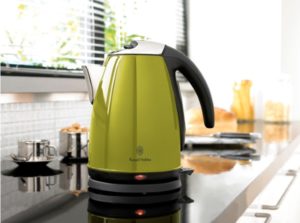 At least once in life, each person has come across the fact that the new kettle smells of plastic. Sometimes this smell and even taste are transmitted by the boiled water in it. What to do in this case, why this happens and what is fraught with neglect of this problem, we will consider below.
At least once in life, each person has come across the fact that the new kettle smells of plastic. Sometimes this smell and even taste are transmitted by the boiled water in it. What to do in this case, why this happens and what is fraught with neglect of this problem, we will consider below.
Where does the unpleasant "aroma" come from and what is it fraught with
To understand whether the use of a “flavored” teapot is dangerous in each case, one needs to delve deeper into the problem. We will analyze the most common causes of the appearance of an unpleasant odor, namely:
- Not aired. The first and safest of the causes of odor is dense factory packaging. The smell of plastic simply does not have time to weather out of the new product and gets into your house with the purchase. Of course, no one will be engaged in airing the teapots in the fresh air at the factory, but you can do it with ease at home. If the smell is gone - the product is of high quality.
- Low quality materials. Bad smelling teapot can be made of low quality plastic. It is clear that products made of high-quality material are more expensive, but health is priceless. Some unscrupulous manufacturers are trying to save on materials at the expense of consumer health. Food plastic, from which similar products should be made, has no smell, but also costs more. In addition, the kettle is constantly exposed to high temperature loads, and in order to extend its service life, many plasticizers and dyes are added to the composition of the plastic. Without the latter, the appearance is poor. If these impurities are of poor quality, odor is also inevitable. The most unpleasant thing in this story is that when heated, this cocktail dissolves safely in water, making it a slow poison for any human body.
- It's time to change. It happens that the kettle served you faithfully for some time, without giving reason to doubt its safety. And it doesn’t matter - a week or five years - such symptoms can appear at any time. There was no smell, and then all of a sudden, it appeared one fine morning, ruining the user's mood and appetite. This phenomenon indicates that the kettle’s plastic has already worked out its life and has begun to gradually disintegrate, dissolving directly in water. In this case, you need to go for a new kitchen assistant in the very near future.
Like any chemicals, plastic particles dissolved in water can be hazardous to health. We are talking, of course, about cheap raw materials, which at the same time have their own specific smell. Food plastic, as mentioned above, does not smell and does not pose a health hazard.
Options for solving the problem
Of course, the first thing that comes to mind is to immediately get rid of the smelly enemy of health. If you bought this kettle yourself and the warranty is still valid, there should be no problems with the exchange or return. From a legal point of view, the foul-smelling new teapot belongs to low-quality goods and must be returned within two years from the date of purchase. A check must be submitted with an indication of the problem and articles 4, 18 of the Law on the Protection of Consumer Rights. In this case, you are not entitled to refuse a refund or exchange of goods.
If you really want to leave the kettle or for some reason there is no way to change it, you can resort to folk remedies. After their use, it will become clear whether the high-quality plastic was used in the manufacture and whether the “patient needs to be cured”.
Before using any kettle, it is recommended to boil several times - this is indicated in the instructions. What else to do before using a new kettle if the smell is not gone? There are several options:
- Citric.Cut 3-4 lemon or a couple of bags of citric acid directly into the kettle in large slices, pour water to the maximum mark. Then boil and leave the cocktail overnight. In the morning, after repeated boiling, pour the resulting mixture into the sewer. In the best case scenario, the smell should go away or decrease greatly. If after three such procedures there is no result - "the patient is more likely dead than alive." By the way, the scum is cleaned perfectly and safely in the same way.
- Acetic. In a ratio of 1: 1 use vinegar with water. Actions and result as in the previous paragraph. You just need to be prepared for a blend of boiling vinegar and plastic, it is better to do this procedure in the summer with the windows open.
- Soda. Two liters of water takes half a glass of ordinary baking soda. Boil once, allow to cool. Pour out the liquid and rinse the kettle thoroughly with plenty of water.
- Laurel. Boil a full teapot with a few leaves of lavrushka.
If none of the above actions has brought the desired result, you need to immediately get rid of a harmful purchase without any regret.

It is better to buy a quality kettle more expensive than, having saved on it, to pay several times more for treatment.